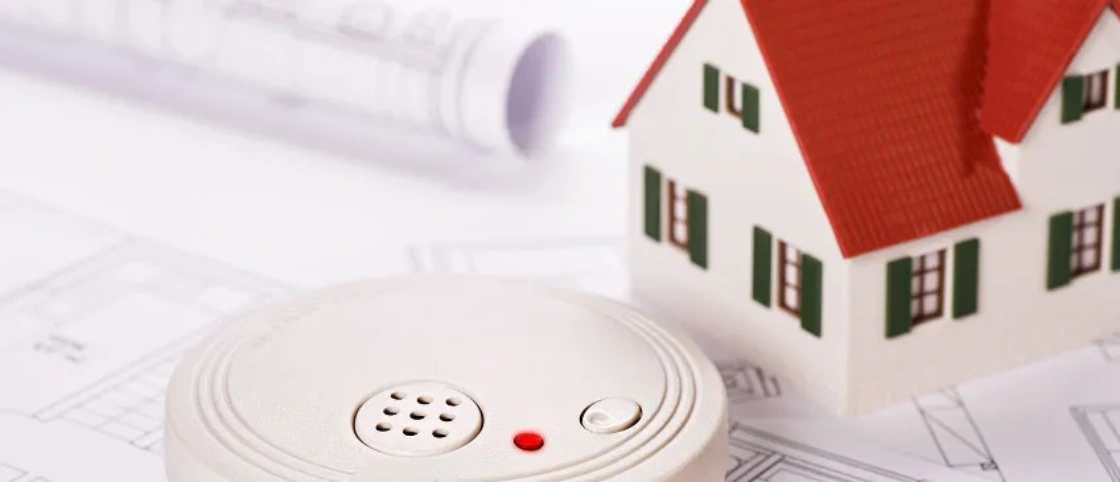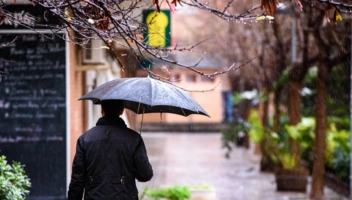Fireproofing Your Home: 15 Ways to Harden Your Home for Fire Prevention

Roughly 69,000 wildfires occurred in 2022, burning just over 7.5 million acres and threatening millions of homes. Whether from direct flames, radiant heat, or flying embers – small, hot, fiery sparks from the burning material, harden your home for fire prevention to reduce the risk of flames spreading.
Flying embers, which can travel up to one mile away, are a wildfire’s leading cause of most home ignitions. Having our LeafFilter Gutter Protection system professionally installed is one way to help harden your home. Our award-winning, patented gutter guards block debris from entering your gutters; therefore, there’s no built-up debris for flying embers to ignite.
Getting your home, property, and neighborhood ready for fire prevention is a multi-step process. First, keep your property clean and well maintained so it’s less vulnerable to ignition from flying embers. Secondly, harden your home so it’s more resistant to catching fire due to flames, heat, or embers.
Protect your surrounding land by creating a defensible space around your home. Consider restructuring the interior and exterior of your house with ignition- and fire-resistant, noncombustible materials. Get a jump on prepping your home and read on to discover 15 ways to harden your home for fire prevention.
In this article:
- Create a Defensible Space
- Consider a Roof Replacement
- Rebuild Walls and Replace Siding with Ignition-Resistant Material
- Protect the Underside of Eaves
- Replace Windows with Tempered Glass
- Cover Rain Gutters
- Secure Vent Openings
- Take Care of Skylights
- Secure Decks and Patios
- Screen Off Chimneys and Stovepipes
- Ready Your Garage
- Upgrade Fences and Outbuildings
- Ensure Immediate Access for Emergency Crews
- Prepare an Emergency Kit and Evacuation Plan
- Get Involved in the Community
- Final Thoughts
- Frequently Asked Questions
1. Create a Defensible Space

Image by dimitrisvetsikas1969 via Pixabay
Follow the three zoning rules set forth by the Wildfire Home Retrofit Guide to create a defensible space around your home to help reduce the risk of fire. Give your property a 100-foot buffer by designing your landscape appropriately. The main things to consider include:
- Keep storage sheds and other outbuildings away from your home.
- Mow the grass, cut back thick vegetation, and thin out dense trees.
- Prune overhanging trees if they’re close to your house or could catch fire from a nearby shrub.
- Scatter plants and bushes to create a fuel break if they’re within 30 feet of your home, garage, or shed.
- Keep wood piles and fuel tanks at least 30 feet from all flammable structures.
- Hydrate surrounding plants, grass, and vegetation, and use noncombustible mulch.
- Have a 100-foot garden hose installed and ready to use.
- Ensure emergency crews can find your address and driveway.
For homes on steep slopes or in windy areas, the more defensible space you create, the better. Houses situated at the top of a slope are at risk of upslope fuels, and this can result in a more intense fire. Consider lengthening your defensible space if this is the case.
If your home is in a dense neighborhood, reduce the likelihood of building-to-building ignition by thinning out any shrubs or trees between homes. Keep clutter or flammable objects at least 30 feet away. Politely engage with your neighbors to prioritize creating and increasing a defensible space between your properties.
2. Consider a Roof Replacement
Replace your existing roof with noncombustible materials as a way to harden your home for fire prevention. It’s no secret that wood burns easily and therefore, wood roofing is most at risk. A roof replacement using materials such as metal, clay, or tile, can help reduce the risk of fire, especially if the metal shingles are class A fire-resistant.
Clean and inspect your roof regularly and make repairs immediately to ensure your roof stays in top-notch condition and free of flammable debris. Check your roof for exposed spaces and plug any gaps with caulking to prevent fire embers from entering the attic or other vulnerable areas. Protect roof edges with metal flashing and ensure there is a fire-resistant underlayment between the roof sheathing and roof covering.
3. Rebuild Walls and Replace Siding with Ignition-Resistant Material

When you’re considering redoing your roof, consider your inside walls and exterior siding as well. Just like your roof, a home made of wood is at a higher risk, and your siding could be vulnerable if it’s not made from noncombustible materials. Siding that ignites can cause serious damage to your home and increase the risk of spreading.
Restructure your home’s walls and siding with materials like stone, brick, cement, stucco, or metal. Aside from lending stylish curb appeal to your house and property, these strong materials help prevent fire ignition from radiant heat or flying embers that may come from a nearby structure or vegetation. Don’t forget smaller areas, such as where the roofing meets the siding.
4. Protect the Underside of Eaves
Your home’s eaves—the edges of your roof that extend past the walls of your home—are vulnerable to flying embers if there is open construction underneath. This open construction can create gaps where fire embers could enter. Should these embers get caught under the eaves, they could ignite your roof or siding from the inside.
Protect the underside of the eaves with a noncombustible mesh covering or ignition-resistant soffit boxing.
5. Replace Windows with Tempered Glass
Inspect your windows and where they’re situated in your house. Replace your solo-pane windows with dual panes and use one pane of tempered glass. This helps reduce the risk of your windows breaking from the intense heat of fire.
Evaluate where your windows are located in your home and whether or not you consider them usable windows. Install ignition-resistant screens in usable windows to help keep out flying embers.
Minimize the amount of vegetation that may be situated near larger windows. This reduces the risk of radiant heat and direct flames blowing out the window spreading the fire to the surrounding vegetation.
6. Cover Rain Gutters
Open rain gutters aren’t just a pain to clean out on a regular basis, but they also increase the risk of fire from flying embers igniting your home. If embers hitting dry leaves or vegetation spark a fire in the gutter, the flames can reach the roof edges and under the eaves rather quickly. Enclose rain gutters with a noncombustible material to help prevent an accumulation of dry, dead vegetation or other flammable debris.
Consider an option like LeafFilter for fire prevention. Our award-winning gutter protection system keeps your rain gutters free and clear of twigs, pests, and leaves while letting water flow through easily. Made from a durable uPVC material and stainless steel micromesh screen, our patented gutter guards reduce the risk of flying embers igniting anything stuck in the gutters by keeping the debris out.
7. Secure Vent Openings
Secure any vent openings in your roof, eaves, basement, or attic with a fire-resistant metal screen or mesh. Use WUI, or Wildland Urban Interface, rated vents with one-eighth-inch metal mesh to block embers from entering your home. Screened vents allow for proper airflow and ventilation while keeping out plant debris or fire embers that could float through the opening.
Keep vented areas free of combustible items, such as newspapers, cardboard, or magazines, both inside and outside. Inspect your home’s vents regularly to be sure they’re clear of any dead plant material so it doesn’t accumulate and act like kindling.
8. Take Care of Skylights
Just like your home’s other windows, consider outfitting usable skylights with a metal mesh screen so that when they’re open, embers can’t just float through into your home. If you have a plastic-dome style skylight, replace it with a flat-glass style as they have less risk associated with fire.
9. Secure Decks and Patios

Image by JamesDeMers via Pixabay
Build or redo decks and patios using noncombustible materials to harden your home for fire prevention, especially if the deck or patio is close to or touches the house. Though most decks are built with softwood, high-density hardwood features less risk for ignition. If your deck or patio also has a covering, treat it the way you would treat your home’s roof.
Create an undesirable area for embers to ignite a fire. Keep the space underneath your deck clear of yard clutter, wood piles, and unraked leaves. Maintain the top of your deck by sweeping clear forest needles, leaves, and other dry vegetation so the debris doesn’t get stuck in between the gaps of wood, which could catch embers in the wind.
To further harden your home, create a defensible space under and around your deck if it’s on a steep incline. Just because combustible material may be far from your deck vertically, it could still pick up flying embers and ignite the underside of your decking.
10. Screen Off Chimneys and Stovepipes
Escaping embers from your fireplace could ignite your roof and home. Screening off chimney and stovepipe openings helps to reduce this risk.
A metal mesh screen allows smoke to waft out while keeping the fireplace embers in. It also helps to keep natural debris out of your fireplace. Be sure your chimney or stovepipe is well maintained and kept clean for safe use.
11. Prepare Your Garage
Get your garage ready—especially if it’s an attached garage—to help harden your home for fire prevention. Treat the garage as you would your home: create a defensible space around your garage and retrofit it with noncombustible materials. Since volatile materials are often kept in the garage, store them as far away as possible from ignition sources.
Install weather stripping around the garage doors to close any gaps where embers have the potential to sneak through. Cover air vents with fire-resistant mesh and fill holes and openings the garage siding might have. Keep a battery backup for the garage doors in case of a power failure.
Don’t forget about the roof and eaves of the garage, though. Just like for your home, consider installing soffited eaves and rain gutter covers to keep leaves, twigs, and other plant matter from piling up.
Our LeafFilter gutter guards can help you maintain clog-free gutters to prevent damage that can occur from clogged gutters. Outfitting your garage gutters with gutter guards ensures nothing but water gets inside your gutters. By eliminating collected debris in your gutters, you reduce the risk of fire ignition from flying embers.
Our gutter guards are backed by a transferable lifetime warranty. That means it’s transferable to the new owner should you decide to sell your home, which can be a big selling point. In fact, having our gutter guards installed on your home can actually increase the value of your home.
Have you cleaned out your gutters yet? We didn't think so! Schedule your free estimate today and let our team do the rest by visiting https://t.co/4bLZOBDHja #LeafFilter #DebrisFree pic.twitter.com/wgfa3c90EW
— LeafFilter Gutter Protection (@LeafFilter) June 21, 2023
12. Upgrade Fences and Outbuildings
Upgrade fences and outbuildings with noncombustible materials for fire prevention. Fencing that’s flammable could create a fiery path to your home. The California Department of Forestry and Fire Protection recommends upgrading your last 5 feet of fencing with noncombustible material to help break the fuel path.
Clear the base of fences and outbuildings of accumulated yard debris, such as twigs, overgrown grass, or piles of leaves. Trim back bushes and prune back trees to decrease the chance of fire crawling from plant material to building or fence.
13. Ensure Immediate Access for Emergency Crews

Image by Military_Material via Pixabay
An often overlooked way to prepare your home for fire prevention is making sure your address is clearly visible and easy to spot for emergency crews. Beware of low-hanging trees or overgrown shrubbery along your driveway. In the event of a fire, ensure emergency vehicles can safely enter your driveway and are able to reach your home with their fire hoses.
For yourself and potential emergency personnel, maintain the water supply to your house. Consider attaching more than one 100-foot garden hose to help reach your property’s entire defensible area. If your property has a pool, well, or other large source of water, consider getting a pump.
14. Prepare an Emergency Kit and Evacuation Plan
Get ready. A great way to harden your home—and your family—is to prepare. The best time to get ready for an emergency is before it even starts. Create an emergency kit and make an evacuation plan.
Pack an emergency bag, often referred to as a go-bag or bug-out bag, for each individual and pet in the house. Keep them easily accessible in case you need to make a quick departure. Check that your emergency and first-aid kit is up to standards and ready to be used, if necessary.
Follow all evacuation guidelines and make a family plan and ensure it can be implemented when needed. Other preparation tips to consider include:
- Shut off the gas meter
- Turn off pilot lights
- Shut off air conditioning
- Remove flammable material from walls and windows
- Move flammable furniture to the center of the room
- Leave your lights on
- Keep pets with you at all times
15. Get Involved in the Community
Preventing fire from destroying a neighborhood is a community effort. Depending on how close your properties are to one another, it could be crucial to confer with your neighbor about how to harden your homes. Since defensible space is recommended to be 100 feet, you and your neighbor could be within that space together.
Get involved in your community and organize a meeting. Invite your local fire department to help spread awareness on how to get your neighborhood wildfire-ready. Together, develop an action plan to better your environment for fire prevention.
Final Thoughts
A fire can be devastating to your home, and it puts the lives of your family and pets at risk. Taking steps today and making a continuous effort to fireproof your home and surrounding land helps to prevent fires and can also help to minimize the spread should a fire occur.
One of the best ways to help protect your home from flying embers is to have our LeafFilter gutter guards professionally installed. Flying embers can easily get inside your gutters and ignite any buildup of twigs, leaves, and other debris. Our gutter guards block even the smallest debris, such as pollen and shingle grit, from entering your gutters, preventing the buildup of flammable debris.
Our gutter guards are professionally installed by our local experts and are backed by a transferable lifetime warranty, giving you peace of mind knowing that you’ve removed one possible fire risk for the life of your home.
More than 1.2 million homeowners have trusted our award-winning gutter guards to protect their homes. Call us today toll-free at 1-800-290-6106 for a free estimate, or visit LeafFilter.com to learn more.
Frequently Asked Questions
Is there a way to fireproof your house?
There are several steps you can take to reduce the risk of a house fire. Creating a defensible space around your home, using flame-resistant materials for your roof, such as metal roofing, as well as for the walls, siding, and other structural elements of your home.
Consider replacing your windows with tempered glass and rebuilding decks and patios with flame-resistant materials. It’s also important to keep your rain gutters free of leaves, twigs, and other debris that could ignite if a flying ember enters your gutter.
A proven gutter protection system like LeafFilter blocks all debris, even debris as small as shingle grit and pollen, from entering your gutters, allowing only rain to flow through. While it can’t 100% protect your home from a fire, it reduces the risk by keeping flammable debris buildup out of your gutters, giving you an added sense of security.
What does it mean to fireproof your house?
Fireproofing your house means taking steps to reduce the risk of a house fire. That can include many things, such as making improvements to replace flammable materials with noncombustible materials, taking precautions such as screening off chimneys and stovepipes and covering your rain gutters with a proven gutter protection system like LeafFilter to keep flammable debris out of your gutters.
Fireproofing your home isn’t a single, one-time step, but a variety of precautions and preparations that, together, reduce the risk of fire and keep your family safer.
What’s the most fireproof material for a house?
There’s a variety of fire-resistant and fireproof materials you can use throughout your home to help reduce the risk of a house fire. This includes materials such as tempered glass, brick, concrete, metal, stucco, and stone, among others.
How likely is it that my house will catch fire?
There’s no sure way to precisely measure the risk of your house catching fire, but home fires are more common than you may think. According to the National Fire Protection Association (NFPA), a single home fire occurred every 93 seconds in 2021, causing an estimated $3.6 billion in property damage. Taking steps to harden your home for fire prevention is the best way to minimize the fire risk in your home.


